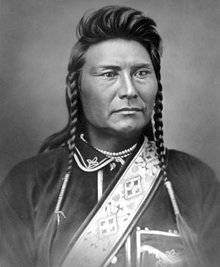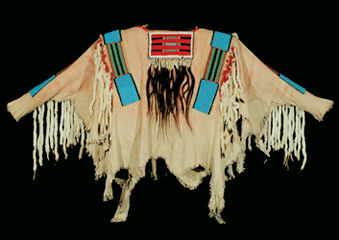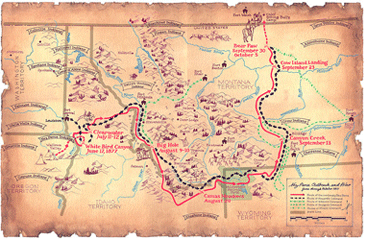|
Chief Joseph
Answer
to Name
This Famous Person Game - March 2017
by Mike McLeod
  Hinmatóowyalahtqit (Thunder Rolling Down the Mountain), or Chief Joseph, was born on March 3, 1840. He took his father’s name of Joseph after their conversion to Christianity. Both were chiefs of the Nez Perce. Hinmatóowyalahtqit (Thunder Rolling Down the Mountain), or Chief Joseph, was born on March 3, 1840. He took his father’s name of Joseph after their conversion to Christianity. Both were chiefs of the Nez Perce.
In 2012, Chief Joseph’s war shirt sold for $877,500 at the Coeur d’Alene Art Auction. The provenance was historic—a painting of him wearing the shirt is in the Smithsonian, and that image was used for a U.S. postage stamp issued in 1968.1
The Nez Perce lived in the Pacific Northwest, and in the early 1800s, they came in contact with Lewis and Clark during their expedition. Years later, homesteaders began moving onto Nez Perce land. Chief Joseph’s father always sought a way to live in peace with the settlers, and he made a treaty with the governor of the Territory of Washington in 1855 which established a reservation for the Nez Perce encompassing about seven million acres. However, that treaty was changed, invalidated, broken, superseded—whatever you want to call it—and replaced with another treaty in 1863 after gold was discovered there. In it, the Nez Perce were given another reservation, but it was just one-tenth the size of the first. Even worse, it was away from their traditional home lands and the sacred burial spots of their ancestors. Some of the Nez Perce chose to move to that reservation; others did not, including Chief Joseph (the son).
Contentions arose when the army demanded the rest of the Nez Perce move to the reservation. This bad situation became tragic when some Nez Perce warriors attacked and killed several settlers. Knowing there would be repercussions, the war chiefs of the tribe and Chief Joseph decided to leave. They set off to join a friendly Crow Tribe in Montana.
|

|
Chief Joseph’s war shirt that sold for $877,500. (Photo courtesy of Coeur d’Alene Art Auction)
|
Nearly 3,000 Nez Perce embarked on what became a 1,000+ mile journey, but they were not allowed to go in peace. The army sent soldiers after them—their departure was considered an act of war—and the Nez Perce with 800 warriors fought 2,000 soldiers in 18 engagements along the way. Traveling across Idaho, Montana, Wyoming (near Yellowstone) and back into Montana, they reached the Crow Tribe. However, the Crows would not take them in; from there, the Nez Perce headed north toward Canada to join Sitting Bull.
|

|
Map “Nez Perce Outbreak and War, June Through October 1877”
|
Just 40 miles from the Canadian border, the army engaged the Nez Perce in a five-day battle, and the Nez Perce surrendered. In the end, about 1,000 Nez Perce, including women and children, died as result of the war with the army.2
The Nez Perce were promised they could return to their reservation, but Commanding General of the Army William T. Sherman ordered them sent to Fort Leavenworth, Kansas, instead. Many died there from disease.
Years later in 1855, Chief Joseph and the surviving Nez Perce—less than 300—returned to the Northwest, but Chief Joseph was sent to a different reservation in Washington than his people.3
Chief Joseph died on September 21, 1904.
“Treat all men alike. Give them the same law. Give them an even chance to live and grow.”4
Ted Carlton of Utah correctly identified Chief Joseph.
----------------------
1
Deseretnews.com, “Chief Joseph’s War Shirt Fetches Nearly $900,000 at Auction,” July 22, 2012.
2, 3
Worldebooklibrary, “Nez Perce War.”
4 Brainquote.com
|